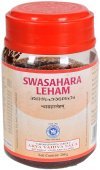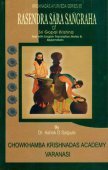Hingula, Hiṅgūla, Hiṅgula, Hiṅgulā, Himgula: 19 definitions
Introduction:
Hingula means something in Hinduism, Sanskrit, Jainism, Prakrit, the history of ancient India, Marathi. If you want to know the exact meaning, history, etymology or English translation of this term then check out the descriptions on this page. Add your comment or reference to a book if you want to contribute to this summary article.
In Hinduism
Ayurveda (science of life)
Rasashastra (Alchemy and Herbo-Mineral preparations)
Source: Wisdom Library: Rasa-śāstraHiṅgūla (हिङ्गूल, “cinnabar”):—Sanskrit name for one of the drugs belonging to the Sādhāraṇarasa group, according to the Rasaprakāśasudhākara: a 13th century Sanskrit book on Indian alchemy, or, Rasaśāstra. Hiṅgūla has various medicinal and alchemical applications, such as stimulating the digestive system. Cinnabar is a non-metallic toxic form of mercury sulfide.
Hiṅgūla is said to have two varieties:
- Śukatuṇḍa (also known as Carmāra),
- Haṃsapāda (also known as Pāka).
Hiṅgūla (cinnabar) is said to have two varieties
- Śukatuṇḍa (also known as Carmāra),
- Haṃsapāda or (Pāka).
Hiṅgūla is dīpana (digestive stimulant), sarvadoṣaghna (destroyer of all doṣas), atirasāyana (best rejuvenator), and sarvarogahara, (curative for all the diseases). It is also recommended for drāvaṇa-karma (may be useful in dhātudrāvaṇa or kāminīdravaṇa).
Unclassified Ayurveda definitions
Source: Ancient Science of Life: Vaidyavallabha: An Authoritative Work on Ayurveda TherapeuticsHiṅgula (हिङ्गुल) or Haṃsapāda refers to Ferula narthex, and is the name of a medicinal plant dealt with in the 17th-century Vaidyavallabha written by Hastiruci.—The Vaidyavallabha is a work which deals with the treatment and useful for all 8 branches of Ayurveda. The text Vaidyavallabha has been designed based on the need of the period of the author, availability of drugs (viz., Hiṅgula) during that time, disease manifesting in that era, socio-economical-cultural-familial-spiritual-aspects of that period Vaidyavallabha.

Āyurveda (आयुर्वेद, ayurveda) is a branch of Indian science dealing with medicine, herbalism, taxology, anatomy, surgery, alchemy and related topics. Traditional practice of Āyurveda in ancient India dates back to at least the first millenium BC. Literature is commonly written in Sanskrit using various poetic metres.
Shaktism (Shakta philosophy)
Source: Wisdom Library: Śrīmad Devī BhāgavatamHiṅgula (हिङ्गुल) is the name of a tree found in maṇidvīpa (Śakti’s abode), according to the Devī-bhāgavata-purāṇa 12.10. Accordingly, these trees always bear flowers, fruits and new leaves, and the sweet fragrance of their scent is spread across all the quarters in this place. The trees (e.g. Hiṅgula) attract bees and birds of various species and rivers are seen flowing through their forests carrying many juicy liquids. Maṇidvīpa is defined as the home of Devī, built according to her will. It is compared with Sarvaloka, as it is superior to all other lokas.
The Devī-bhāgavata-purāṇa, or Śrīmad-devī-bhāgavatam, is categorised as a Mahāpurāṇa, a type of Sanskrit literature containing cultural information on ancient India, religious/spiritual prescriptions and a range of topics concerning the various arts and sciences. The whole text is composed of 18,000 metrical verses, possibly originating from before the 6th century.
Source: Wisdom Library: ŚāktismHiṅgulā (हिङ्गुला) is the name of a Śāktapīṭha mentioned in the Kulārṇavatantra. The Kulārṇava-tantra is an important 11th century work for the Kaula school of Śāktism. It refers to eighteen such Śākta-pīṭhas (e.g. Hiṅgulā) which is defined as a sacred sanctuary of Devī located here on earth. According to legend, there are in total fifty-one such sanctuaries (pīṭha) on earth, created from the corresponding parts of Devī’s body,

Shakta (शाक्त, śākta) or Shaktism (śāktism) represents a tradition of Hinduism where the Goddess (Devi) is revered and worshipped. Shakta literature includes a range of scriptures, including various Agamas and Tantras, although its roots may be traced back to the Vedas.
In Jainism
General definition (in Jainism)
Source: archive.org: Economic Life In Ancient India (as depicted in Jain canonical literature)Hiṅgula (हिङ्गुल) refers to “vermilion”: a mineral that was typically mined, extracted and used (both domestic and industrial) in ancient India. Mining was an important industry at that time as well. The Jaina canonical texts mention about the extraction of various kinds of minerals, metals and precious stones. The term ‘āgara’ occurring intire texts denotes the mines which provided many kinds of mineral products (e.g., hiṅgula). The references in the texts of various professions and trade in metallic commodities clearly show a highly developed industry of mining and metallurgy in that period.

Jainism is an Indian religion of Dharma whose doctrine revolves around harmlessness (ahimsa) towards every living being. The two major branches (Digambara and Svetambara) of Jainism stimulate self-control (or, shramana, ‘self-reliance’) and spiritual development through a path of peace for the soul to progess to the ultimate goal.
India history and geography
Source: Ancient Buddhist Texts: Geography of Early BuddhismHiṅgula (हिङ्गुल) or Hiṅgulapabbata is the name of a mountain situated in Aparāntaka (western district) of ancient India, as recorded in the Pāli Buddhist texts (detailing the geography of ancient India as it was known in to Early Buddhism).—The Hiṅgula-pabbata is in the Himavantapadesa. Hinglāj is situated at the extremity of the range of mountains in Beluchisthan called by the name of Hiṅgulā, about 20 miles or a day’s journey from the sea-coast, on the bank of the Aghor or Hiṅgulā or Hingol river near its mouth.

The history of India traces the identification of countries, villages, towns and other regions of India, as well as mythology, zoology, royal dynasties, rulers, tribes, local festivities and traditions and regional languages. Ancient India enjoyed religious freedom and encourages the path of Dharma, a concept common to Buddhism, Hinduism, and Jainism.
Languages of India and abroad
Marathi-English dictionary
Source: DDSA: The Molesworth Marathi and English Dictionaryhiṅgula (हिंगुल).—m S Vermilion.
--- OR ---
hiṅgūḷa (हिंगूळ).—m (hiṅgula S) Vermilion, a preparation of mercury with sulphur.
Source: DDSA: The Aryabhusan school dictionary, Marathi-Englishhiṅgūḷa (हिंगूळ).—m Vermilion.
Marathi is an Indo-European language having over 70 million native speakers people in (predominantly) Maharashtra India. Marathi, like many other Indo-Aryan languages, evolved from early forms of Prakrit, which itself is a subset of Sanskrit, one of the most ancient languages of the world.
Sanskrit dictionary
Source: DDSA: The practical Sanskrit-English dictionaryHiṅgula (हिङ्गुल).—
Derivable forms: hiṅgulaḥ (हिङ्गुलः), hiṅgulam (हिङ्गुलम्).
--- OR ---
Hiṅgūla (हिङ्गूल).—An esculent root (as of Amorphophallus Campanulatus; Mar. suraṇa).
Derivable forms: hiṅgūlam (हिङ्गूलम्).
Source: Cologne Digital Sanskrit Dictionaries: Shabda-Sagara Sanskrit-English DictionaryHiṅgula (हिङ्गुल).—mn.
(-laḥ-laṃ) Vermilion. f. (-lī) The egg-plant, (Solanum melon gena.) E. hiṅgu asafœtida, lā to take or give, aff. ka .
--- OR ---
Hiṅgūla (हिङ्गूल).—n.
(-laṃ) An esculent root, a sort of yam. “ālu” .
Source: Cologne Digital Sanskrit Dictionaries: Cappeller Sanskrit-English DictionaryHiṅgula (हिङ्गुल).—[neuter] vermilion.
Source: Cologne Digital Sanskrit Dictionaries: Monier-Williams Sanskrit-English Dictionary1) Hiṅgula (हिङ्गुल):—[from hiṅgu] m. n. a preparation of mercury with sulphur, vermilion, [Varāha-mihira’s Bṛhat-saṃhitā]
2) Hiṅgulā (हिङ्गुला):—[from hiṅgula > hiṅgu] a f. See below
3) [from hiṅgu] b f. Name of a country, [Vāmana-purāṇa]
4) [v.s. ...] of the tutelary deity of the Dadhi-parṇas, [Catalogue(s)]
5) Hiṅgūla (हिङ्गूल):—[from hiṅgu] m. a kind of plant ([varia lectio] hijjala), [Pañcarātra]
6) [v.s. ...] n. the edible root of Amorphophallus Campanulatus, [cf. Lexicographers, esp. such as amarasiṃha, halāyudha, hemacandra, etc.]
Source: Cologne Digital Sanskrit Dictionaries: Yates Sanskrit-English Dictionary1) Hiṅgula (हिङ्गुल):—(laḥ) 1. m. Vermilion. f. (ī) The egg-plant.
2) Hiṅgūla (हिङ्गूल):—(laṃ) 1. n. An esculent root, sort of yam.
Source: DDSA: Paia-sadda-mahannavo; a comprehensive Prakrit Hindi dictionary (S)Hiṅgula (हिङ्गुल) in the Sanskrit language is related to the Prakrit word: Hiṃgula.
[Sanskrit to German]
Sanskrit, also spelled संस्कृतम् (saṃskṛtam), is an ancient language of India commonly seen as the grandmother of the Indo-European language family (even English!). Closely allied with Prakrit and Pali, Sanskrit is more exhaustive in both grammar and terms and has the most extensive collection of literature in the world, greatly surpassing its sister-languages Greek and Latin.
Prakrit-English dictionary
Source: DDSA: Paia-sadda-mahannavo; a comprehensive Prakrit Hindi dictionaryHiṃgula (हिंगुल) in the Prakrit language is related to the Sanskrit word: Hiṅgula.
Prakrit is an ancient language closely associated with both Pali and Sanskrit. Jain literature is often composed in this language or sub-dialects, such as the Agamas and their commentaries which are written in Ardhamagadhi and Maharashtri Prakrit. The earliest extant texts can be dated to as early as the 4th century BCE although core portions might be older.
Kannada-English dictionary
Source: Alar: Kannada-English corpusHiṃgula (ಹಿಂಗುಲ):—[noun] mercuric sulfide, a heavy, bright-red mineral, the principal ore of mercury; cinnabar.
--- OR ---
Hiṃguḷa (ಹಿಂಗುಳ):—[noun] = ಹಿಂಗುಲ [himgula].
Kannada is a Dravidian language (as opposed to the Indo-European language family) mainly spoken in the southwestern region of India.
Nepali dictionary
Source: unoes: Nepali-English DictionaryHiṅgula (हिङ्गुल):—n. vermilion;
Nepali is the primary language of the Nepalese people counting almost 20 million native speakers. The country of Nepal is situated in the Himalaya mountain range to the north of India.
See also (Relevant definitions)
Starts with: Hinguladi, Hingulaja, Hingulaka, Hingulapabbata.
Ends with: Chingula.
Full-text (+12): Hinguli, Haingula, Himgula, Japakusumasamnibha, Hamsapada, Hingulaka, Shukatunda, Hingulapabbata, Hingulaja, Hingaluka, Hinguluka, Hingola, Hingali Lakha, Ilinkaparpam, Ilinkakkattu, Kulikacceppu, Paka, Carmara, Saprabha, Maniraga.
Relevant text
Search found 17 books and stories containing Hingula, Himgula, Hiṃgula, Hiṃguḷa, Hiṅgūla, Hiṅgula, Hiṅgulā, Hiṅgūḷa, Hiṅguḷa, Hinguḷa; (plurals include: Hingulas, Himgulas, Hiṃgulas, Hiṃguḷas, Hiṅgūlas, Hiṅgulas, Hiṅgulās, Hiṅgūḷas, Hiṅguḷas, Hinguḷas). You can also click to the full overview containing English textual excerpts. Below are direct links for the most relevant articles:
Rasa Jala Nidhi, vol 2: Minerals (uparasa) (by Bhudeb Mookerjee)
Part 2 - Purification of Hingula (cinnabar) < [Chapter XXIII - Uparasa (23): Hingula (cinnabar)]
Part 3 - Preparations of Hingula < [Chapter XXIII - Uparasa (23): Hingula (cinnabar)]
Part 1 - Characteristics of Hingula (cinnabar) < [Chapter XXIII - Uparasa (23): Hingula (cinnabar)]
Chaitanya Bhagavata (by Bhumipati Dāsa)
Verse 2.7.58 < [Chapter 7 - The Meeting of Gadādhara and Puṇḍarīka]
Rasa Jala Nidhi, vol 1: Initiation, Mercury and Laboratory (by Bhudeb Mookerjee)
Part 3 - Mercurial operations (1): Purification of Mercury (shodhana) < [Chapter IV-V - Mercurial operations]
Part 2 - Eighteen different kinds of Mercurial operations < [Chapter IV-V - Mercurial operations]
Part 3 - Drawing of a hexagonal lotus diagram < [Chapter II - Initiation of Disciple]
Rasa Jala Nidhi, vol 4: Iatrochemistry (by Bhudeb Mookerjee)
Treatment for fever (31): Jvara-dhuma-ketu rasa < [Chapter II - Fever (jvara)]
Cosmetics, Costumes and Ornaments in Ancient India (by Remadevi. O.)
1. Materials for Cosmetics (Introduction) < [Chapter 1 - Cosmetics]
3.6. Ornamental Painting < [Chapter 1 - Cosmetics]
Rasa Jala Nidhi, vol 3: Metals, Gems and other substances (by Bhudeb Mookerjee)
Part 5 - Incineration of Yellow Diamonds < [Chapter XIII - Gems (1): Vajra or Hiraka (diamond)]
Part 4 - Nectarization of lead < [Chapter VII - Metals (7): Sisaka (lead)]
Part 6 - Incineration of iron (1-25) < [Chapter IV - Metals (4): Lauha (iron)]
Related products
(+4 more products available)





